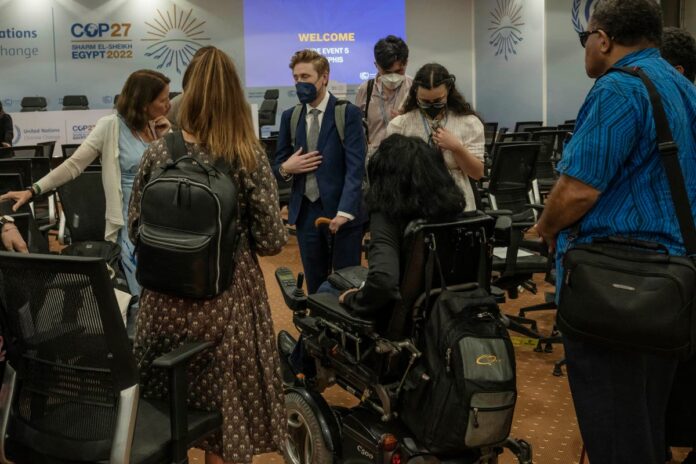Last year, climate activists who focus on disability rights scored a major victory at the United Nations climate change conference known as COP. They gained official status as a caucus recognized by the U.N. Secretariat, the conference organizer. They say it was the culmination of years of effort to be officially included in the proceedings. Here’s what that means for this week and beyond.COP27 CONFERENCESomeone from the caucus will have the chance to address conference attendees at the closing plenary about disability inclusion. People will have an official space to gather. Members of the caucus will also have more access to the conference organizer, making it easier to connect with other attendees including country delegates, negotiators, disability rights organizations, as well as to participate overall in events.This year there have been two changes to make the venue more accessible to people with disabilities, according to Kera Sherwood-O’Regan, an indigenous and disabled climate activist from New Zealand. People with mobility issues or chronic pain may enter the conference via a separate line, so they don’t have to wait as long, and there are more ramps into buildings and onto some of the stages.Still, there is a lot more the conference organizers can do to ensure that the proceedings are accessible to all, like making sure attendees who use wheelchairs or walkers can move around the venue freely and that sign language interpreters are at all events, said Jason Boberg, a member of the disability caucus and a founder of the disability climate action network SustainedAbility.The issue of payment for harm caused by climate change, known in the jargon as ‘loss and damage,’ is also on the agenda for people with disabilities. Activists want to include disability rights in conference negotiations on this subject.Boberg has been a key proponent in pushing for inclusion of disabled communities in climate action at the international level.He said figuring out where loss and damage finance will come from and how to secure some of it for disabled people living in disaster-prone areas is ‘front of mind’ for members of the disability caucus. NEXT OBJECTIVESBoberg said one of the next goals will be formal elevation of the new caucus to the level of a ‘constituency’ within COP.Constituencies are umbrella groups of other organizations such as Indigenous alliances, business and industry coalitions, or farmers and agricultural associations. A disability constituency would have the authority to convene meetings with government officials and suggest speakers and attendees for official COP functions. They would have the right to participate at workshops and events that are otherwise closed. ‘We are the most impacted because we’re left behind, we’re left on the sidelines and our voices need to be there,’ said Dee Woods, the food justice policy coordinator for the U.K.-based agricultural union The Landworkers’ Alliance, at a November 2021 event that was held in Glasgow during last year’s conference, but was unaffiliated with the U.N.Boberg said also that it is important for people with disabilities to be included in something called the U.N.’s Action for Climate Empowerment short-term action plan, which will be hashed out in the coming days. This is the U.N.’s framework for getting people, organizations and communities to reduce emissions and prepare for the effects of climate change. Last year, COP delegations adopted a 10-year plan to roll out the Action for Climate Empowerment. ‘It’s really crucial for disabled people and organizations to be included” in those plans, Boberg said, so they can get more resources from countries for climate action and prepare for climate emergencies. This could mean assurance that relief shelters are accessible. Or it could mean the creation of registries of disabled people, to help governments deliver extra assistance to the right places in the lead up to extreme weather. It also could mean help cleaning up in the aftermath.Activists are also pushing to ensure disability rights are included in international climate action plans, since there are over 1 billion people in the world living with a disability, according to the World Health Organization.GETTING THIS FARThe recognition of the disability caucus by the leadership of the U.N. climate conference last year was a milestone. People have been meeting and organizing on this unofficially at the conference since COP23 in 2017 in Bonn, Germany.’Back then (we’d meet) in the corridors and cafes and wherever we could get a space,’ Boberg said.He was able to give the disability caucus’ first-ever address to conference attendees last year. In it, he said world leaders and society at large have considered disabled people as ‘expected losses’ to climate change. He implored world leaders to include human rights and indigenous and disabled people’s rights in Article 6 of the Paris climate agreement, which outlines how countries can achieve pledges they’ve made to reduce emissions and promote sustainable development.’Until parties recognize disabled leadership on climate and uphold our rights, this COP will be critiqued as an exclusionary event where disabled people are missing,’ he said in that 2021 statement.Just days before he spoke, Israel’s energy minister Karine Elharrar, a wheelchair user, was prevented from getting into a conference event where she was slated to speak.Boberg told The Associated Press in an interview days before he departed this year for COP27 that more than once he’s seen language that recognizes disability rights appear in draft text of negotiations – for example funding disability rights organizations to do climate action work. But the language was cut from the final agreements at the negotiations.Sherwood-O’Regan said it’s ‘really disappointing’ when that happens.’You hope for the best, but plan for the worst and I like to keep my expectations not too high,’ she said. ‘That sounds really cynical but that makes it a little bit easier to engage in the process.’___Follow Drew Costley on Twitter: @drewcostley.___The Associated Press Health and Science Department receives support from the Howard Hughes Medical Institute’s Department of Science Education. The AP is solely responsible for all content.


